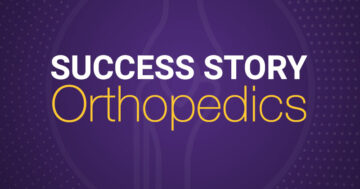What Are APMs in Healthcare?

This blog was originally published on January 31, 2023 and updated on April 23, 2025.
Alternative payment models (APMs) provide incentives for providing high-quality care, controlling costs and moving away from traditional fee-for-service (FFS) payments. They’re also part of the Quality Payment Program (QPP) under the Medicare Access and CHIP Reauthorization Act of 2015 (MACRA). Under QPP, physicians are accountable for achieving specific performance measures that contribute to industry-wide priorities, like quality of patient care, costs to deliver care and interoperability.
What do APMs mean for you?
APMs were designed to improve healthcare quality and efficiency by incentivizing providers to focus on patient outcomes rather than service volume and promoting innovation in care delivery and cost control.
Financial incentives:
- Starting in 2026, physicians participating in qualifying APMs will receive a higher Medicare conversion factor (+0.75 percent compared to +0.25), are exempt from MIPS, and are eligible for any model-specific performance payments, according to the American Medical Association1
Reduced administrative burden:
- When providers participate in certain Advanced APMs, they can be exempt from MIPS reporting requirements
Types of alternative payment models
The type of alternative payment model that applies to your practice may depend on a variety of factors, including your practice specialty and other details about how you provide care. For example, an orthopedist may join an APM designed to improve care for joint replacement, while a urologist may join a model that addresses the care of beneficiaries with End Stage Renal Disease.
Each model directs service delivery and payment so that the healthcare system as a whole can build practices and processes that are higher quality, more affordable, patient-centered and equitable.
The Centers for Medicare & Medicaid Services (CMS) have created six model categories.2 Each category drills down into individual models, each with its own relevance to certain specialties and its own specifications for performance indicators.
- Accountable Care Organizations models (ACOs): Here, a doctor, group of healthcare providers or hospital takes financial responsibility for improving quality of care. This includes providing advanced primary care services, care coordination and health outcomes for a defined group of patients. ACOs are designed to reduce care fragmentation and unnecessary costs for patients and the health system as a whole.
- Disease-specific and episode-based models: Created to address gaps in care for a defined population with a common disease or medical condition, procedure or care episode.
- Health plan models: These include Medicare Advantage plans, which are private insurance alternatives to Medicare that offer extra benefits and emphasize coordinated care.
- Prescription drug models: These aim to improve access to and/or the cost of prescription drugs covered under Medicare (Part B and D) or Medicaid.
- State and community-based models: In these cases, a state or community-based organization — such as a managed care organization — acts as the main contractual participant serving Medicare beneficiaries.
- Statutory demonstrations and other projects: These are subject to testing as mandated by Congress and/or the Secretary of Health and Human Services.
What are Advanced APMs?
Advanced APMs offer incentives for meeting participation thresholds which are determined by your levels of payments or patients. If you achieve these thresholds, you become a Qualifying APM Participant (QP).
In the 2025 performance year, eligible clinicians who reach or surpass these levels will be eligible for a higher update to the physician fee schedule, based on the QP conversion factor. This higher conversion factor for QPs is applied to Medicare payments for covered professional services. QPs are also excluded from MIPS reporting requirements and related payment adjustments.3
To be an Advanced APM, the APM must require the use of certified EHR technology (CEHRT)4 — this is just one of the requirements set forth by CMS. Our EMAⓇ and gGastroⓇ EHR software systems are considered ONC-Certified Health IT, meeting the standard set for Advanced APMs.
Learn more about the 2025 requirements for Advanced APMs.
APMs, MIPS … and MIPS APMs
Under MACRA, physicians are reimbursed through two main tracks: APMs and MIPS. MIPS uses a set of data-driven performance metrics to score a provider’s delivery of value-based care as part of MACRA’s QPP. Clinicians participating in APMs may be exempt from MIPS, however, there are also MIPS APMs.5 Participants in these APMs may choose to report through the APM Performance Pathway (APP), MIPS Value Pathways or Traditional MIPS. ACOs participating in the Medicare Shared Savings Program may be required to report through the APP to assess their quality performance under the program.
Learn more about the 2025 requirements for MIPS APMs.
What are Other Payer Advanced APMs?
Other Payer Advanced APMs are non-Medicare Fee For Service (FFS) payment arrangements with other payers. These payers include3:
- Medicaid
- Medicare Health Plans, such as:
- Medicare Advantage
- Medicare-Medicaid Plans
- 1876 Cost Plans
- Programs of All-Inclusive Care for the Elderly (PACE)
- Payers with arrangements in Aligned Other Payer Models
- Other commercial and private payer arrangements that meet the criteria for Other Payer Advanced APMs
The criteria for payment arrangements to be Other Payer Advanced APMs are similar to those for Advanced APMs with a few exceptions.6 Some of these requirements include:
- Use of CEHRT
- Payments for covered professional services on quality measures that are comparable to those used in the MIPS Quality performance category
- Participants to bear financial risk
Learn more about the 2025 requirements for Other Payer Advanced APMs.
2025 APM reporting requirement updates
Each year, CMS releases updates to its APM policies. These updates are intended to reflect the evolution of healthcare while contributing to cost-effectiveness. According to CMS, key changes for 20257 include:
- The APP Plus quality measure set will be an optional measure set for MIPS-eligible clinicians, groups and APM Entities that participate in a MIPS APM but will be required for Shared Savings Program ACOs.
- The APP Plus quality measure set will be comprised of 11 measures, consisting of 6 measures available in the original APP measure set, and 5 additional measures from the Adult Universal Foundation measure set. Some of these measures will be incorporated in 2025, the rest will follow over time.
- Shared Savings Program ACOs will be required to submit their measures through Electronic Clinical Quality Measures (eCQMs), MIPS CQMs or Medicare CQMs (or any combination of the 3) in the 2025 and 2026 performance years. The MIPS CQMs collection type won’t be available in the 2027 performance year.
- ACOs reporting Medicare CQMs would be scored using flat benchmarks for the measures’ first two performance periods in MIPS.
- CMS finalized a Complex Organization Adjustment that gives one extra measure achievement point for each submitted eCQM that meets requirements, which cannot exceed 10% of the total measure achievement points available in the quality performance category.
- There will be a 75-point performance threshold for the 2025 performance year, affecting payments in 2027.
Is your EHR vendor helping you see the value of value-based care?
APMs, MIPS Value Pathways, Traditional MIPS. At ModMed, we have embraced the arrival of value-based care in all its forms. Our EHR systems, EMA and gGastro, are ONC Health IT Certified, and our CMHP-Certified MIPS Advisors and built-in software and registry solutions8 are here to help you meet your value-based care goals, whatever they may be.
Learn more about our EMA and gGastro value-based care solutions.
1 Medicare alternative payment models, The American Medical Association, August 9, 2024
2 Model Categories and Stages, CMS.gov, November 5, 2024
6 All Payer Advanced APMs, CMS.gov
7 Calendar Year (CY) 2025 Medicare Physician Fee Schedule (PFS) Final Rule: Quality Payment Program Fact Sheet
8 Available for our EMA EHR only







